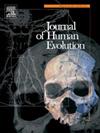在法国伊斯图里茨(Isturitz)的奥里尼亚纪(Aurignacian)群在大约4.2万年前到达西欧时适应了不断变化的环境
IF 3.1
1区 地球科学
Q1 ANTHROPOLOGY
引用次数: 0
摘要
海洋同位素阶段 3 的气候相当不稳定。在全球气候变化及其对当地生态环境和人类所捕食的猎物的影响之间建立联系具有挑战性。不过,我们仍有必要更好地了解人类生活的当地条件,以了解他们是如何适应波动的环境条件的。在这里,我们通过研究伊斯图里茨人类群体捕猎和食用的 250 种动物的骨齿元素来解决这个问题。伊斯图里茨是一个内容丰富、资料翔实的法国考古遗址,也是西欧最早证实奥里尼亚克技术文化的遗址之一。为此,我们建立了一个多代理方法(考古动物学、三维牙齿微磨损纹理分析、珐琅质生物磷灰石中的δ18O和δ13C以及骨胶原中的δ13C、δ15N和δ34S的稳定同位素分析),为我们提供了一条从动物生命最初几年到最后几天的时间线。我们重建了伊斯图里茨不同奥里尼亚克期的生态和古环境。我们的研究结果表明,伊斯图里茨最早的人类活动发生在寒冷和干旱的条件下,并迅速变得更加寒冷和干燥。尽管在这种不稳定的气候条件下,降雨量、温度发生了显著变化,环境逐渐开阔,动物群落也发生了一些变化,但在人类-环境-猎物关系中观察到的变化有限。我们的研究结果表明,在整个时间序列中,人类群体在相似的地域狩猎,并使用相似的策略。我们的多代理方法结合了互补性分析,使我们能够更好地理解西欧出现上旧石器时代第一阶段时的适应策略。本文章由计算机程序翻译,如有差异,请以英文原文为准。
Aurignacian groups at Isturitz (France) adapted to a shifting environment upon their arrival in Western Europe ∼42,000 years ago
The Marine Isotope Stage 3 is a context of considerable climatic instability. Establishing the link between global climate changes and their impact on the local ecological contexts and prey exploited by human populations is challenging. Still, it is necessary to understand better the local conditions where humans lived to unravel how they adapted to fluctuating environmental conditions. Here, we address this question by studying 250 osteodental elements from animals hunted and consumed by human groups at Isturitz, a rich and well-documented French archaeological site and one of the earliest in Western Europe where the Aurignacian technoculture has been attested. To do so, we set up a multiproxy approach (archaeozoology, three-dimensional dental microwear texture analyses, and stable isotopic analyses of δ18O and δ13C in enamel bioapatite and δ13C, δ15N, and δ34S in bone collagen) that informs us on a timeline from the first years to the last few days of an animal's life. We reconstructed their ecologies and paleoenvironments during the different Aurignacian phases at Isturitz. Our findings indicate that the first human occupations at Isturitz occurred under cold and arid conditions, rapidly becoming even cooler and drier. Limited changes are observed in the human-environment-prey relationship despite this unstable climatic context where significant changes in rainfall, temperature, and a gradual opening of environments and some changes in the faunal assemblage occurred. Our findings suggest that human groups hunted in similar territories and utilized comparable strategies throughout the temporal sequence. Our multiproxy approach, combining complementary analyses, provides a better understanding of the adaptation strategies when the first phases of the Upper Paleolithic were emerging in Western Europe.
求助全文
通过发布文献求助,成功后即可免费获取论文全文。
去求助
来源期刊

Journal of Human Evolution
生物-进化生物学
CiteScore
6.30
自引率
15.60%
发文量
104
审稿时长
3 months
期刊介绍:
The Journal of Human Evolution concentrates on publishing the highest quality papers covering all aspects of human evolution. The central focus is aimed jointly at paleoanthropological work, covering human and primate fossils, and at comparative studies of living species, including both morphological and molecular evidence. These include descriptions of new discoveries, interpretative analyses of new and previously described material, and assessments of the phylogeny and paleobiology of primate species. Submissions should address issues and questions of broad interest in paleoanthropology.
 求助内容:
求助内容: 应助结果提醒方式:
应助结果提醒方式:


